Editorial Note: We are an inventory management software provider. While some of our blog posts may highlight features of our own product, we strive to provide unbiased and informative content that benefits all readers.
Demand forecasting is a process that predicts future demand for a product, service or activity. It is also referred to as market forecasting or sales forecasting.
Demand forecasting helps a business to determine the right quantity of purchase and production to meet customer demands and needs.
Inventory optimization maintains the optimized inventory levels based on forecasted demand to minimize the risk of understock, overstock, and deadstock.
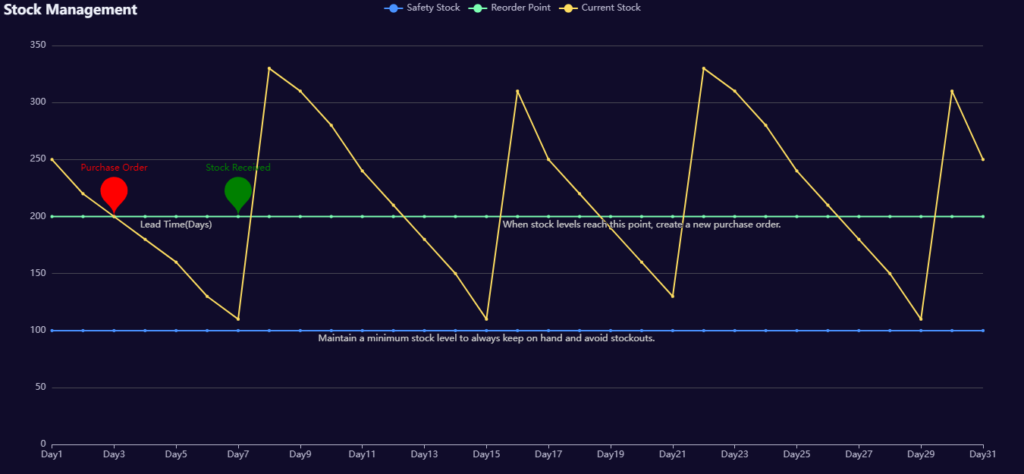
Traditionally, businesses have faced challenges in optimizing their inventory levels. Advanced demand forecasting and inventory optimization software can help businesses manage their inventory more efficiently.
Inventory optimization allows you to reduce working capital (by reducing unnecessary inventory) and improve your Cash Flow. It ensures that inventory levels are optimized to meet consumer demand, without holding excess inventory.
- How much money will you need for purchase & production?
- How can I ensure that my inventory levels are at the optimal level?
Different forecasting models forecast demand based on various factors.
This article will discuss how to implement a sound inventory strategy to maintain the appropriate product flow for your business. With the proper inventory controls in place, you are better assured of having enough products on hand to satisfy demand and avoid missed opportunities.
Demand Forecasting and Inventory Management:
Demand forecasting is the prediction of future demands. To predict the future and optimize inventory levels you need previous data that is stored in your inventory management system. To manage and track inventories, businesses use inventory management software and store data after inventory movements and this data from the inventory management system is needed while predicting demands for the future. So, demand forecasting and inventory management are co-related with each other.
The objective of demand forecasting is to optimize inventory levels to meet customer demands without having excessive inventory.
Demand Forecasting:
Demand forecasting is the process of predicting future demand for a product or service. Demand forecasting is used in the creation of purchase and production schedules, and in optimizing inventory levels.
Demand forecasting can be done by using statistical methods that are based on past data such as exponential smoothing and regression analysis.
Another way to forecast demand is market research or survey.
The use of an appropriate demand forecasting method can help businesses make informed supply decisions by estimating future sales and revenue. An accurate forecasting process results in better forecast accuracy.
Factors That Can Impact Demands:
There are different types and numbers of factors that significantly impact demands. Factors that can impact future demands can vary from business to business.
Here, are the five most common factors that impact forecasting and future demands.
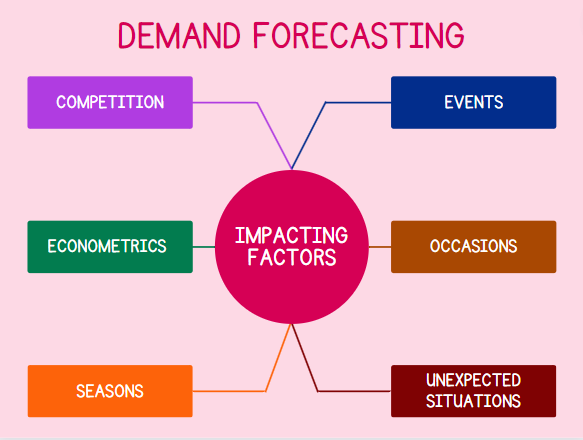
1. Competition:
As businesses become more competitive in terms of quality and price, it is important to consider your competitive position and future plans for these factors before forecasting future demand. Demand is heavily influenced by both product quality and pricing.
If your business offers high-quality products at affordable prices, demand is likely to increase significantly. Conversely, if your competitors offer higher-quality products at more attractive prices, demand for your products is likely to decrease rapidly in the future.
2. Econometrics:
Economic growth in a country or region increases demand for goods and services, while economic decline reduces demand. Before forecasting demand, forecasters should observe and forecast economic indicators to predict changes in demand.
3. Seasons:
Some goods, such as apparel, are seasonal and their demand fluctuates rapidly during certain times of the year. For example, demand for winter and summer clothes differs in terms of types and prices. Businesses must ensure they have the right products in stock at the right time, depending on the season.
4. Events:
Events can significantly impact demand for certain goods. For example, the FIFA World Cup and other sporting events can dramatically increase demand for specific products, such as sportswear and team merchandise. Businesses should consider upcoming events that could affect their business before forecasting future demand.
5. Occasions:
Occasions, such as national events (e.g., Victory Day, International New Year’s Eve, Black Friday) and religious holidays (e.g., Eid, Christmas), can significantly impact demand for certain products. Businesses should consider these occasions when forecasting future demand, as the impact can vary depending on the industry.
6. Unexpected Situations:
Unexpected events, such as the COVID-19 pandemic and the Ukraine-Russia crisis, can severely impact demand on a large scale. These events can be difficult or impossible to predict, but a good business strategy can help your business weather these storms.
Types of Demand Forecasting :
To forecast the future, you need data. A forecasting model predicts the future based on both quantitative and qualitative data. Inventory forecasting works by analyzing this data, which can be either quantitative or qualitative.
After the analysis, the inventory forecasting tool predicts future demand and sets safety stock and reorder points for each product.
1. Quantitative Demand Forecasting :
Quantitative forecasting uses historical data to predict future values using mathematical models. It is an effective method for short-term forecasting. One type of quantitative model is the linear model, which assumes that the future value will be proportional to the past value.
If you sold 10 units in the previous period, the model would predict that you will sell 10 units in the future period. Another type of quantitative model is the historical growth rate model, which assumes that the future growth rate will be equal to the average growth rate of the past several periods.
In other words, if you sold 2 units more in each of the previous 3 periods, the model would predict that you will sell 2 units more in the future period.
2. Qualitative Demand Forecasting :
Qualitative forecasting uses subjective judgments, such as expert opinions, market research data, and customer feedback to predict future demand. It is often used in situations where historical data is limited or unreliable, or where the future is expected to be significantly different from the past.
Qualitative forecasting can be carried out by a team of experts or by AI-based forecasting software.
Demand Forecasting Strategies:
There are different types of strategies for forecasting demand. Demand forecasting can be passive, active, or internal, and can be done at a macro-level or micro-level depending on the nature of the business, goods, and market conditions.
1. Passive demand forecasting:
Passive demand forecasting predicts the future based on past sales. Here, there is no need for a complex method and statistical analysis, it simply takes previous sales trends and predicts the same for the future. Though passive forecasting is fairly easy to calculate, it’s useful for most SMEs including local retailers having a lot of historical data.
When a business uses a computerized inventory management system, all data related to inventory movements, including sales and fulfillment, is stored year after year. A simple demand forecasting tool can easily pull historical sales data from the inventory system and predict the future with ease.
2. Active demand forecasting:
Active demand forecasting is more complex than passive demand forecasting where an advanced forecasting model considers industry growth rates, business growth plans, economic outlook, competitive positions in the market, and more.
Startup businesses and rapidly growing companies use active demand forecasting. Large-scale businesses tend to use this model more compared to SMEs.
3. Macro-level demand forecasting:
Macro-level demand forecasting focuses on overall business economic conditions, external forces, and other factors that can broadly affect the business.
4. Micro-level demand forecasting:
Micro-level demand forecasting focuses on a particular segment, which can be a specific industry, location, or customer segment. This type of forecasting is an effective model that can provide outstanding business success.
5. Long-term demand forecasting:
Long-term forecasting refers to forecasting demand for a period greater than a year. In some cases, the demand for certain goods remains unchanged or the growth rate is almost the same year after year. In such cases, long-term forecasting can be effective.
6. Short-term demand forecasting:
Short-term forecasting refers to forecasting demand for less than a year. Market trends for some goods are changing rapidly, and for these businesses, short-term forecasting is effective.
7. Internal demand forecasting:
A business has some internal objectives and business expansion plans. Supposedly, a business projects to triple its business in the next three years. A business has to ensure three times more supplies and production capacities than the present to meet future customer demands.
Demand Forecasting Methods:
There are different methods for forecasting demand used by different types of businesses based on their preferences. Choosing the right one can boost your business performance. But, using the wrong methods can be a disaster for your business.
Here, I discuss some common methods of demand forecasting:
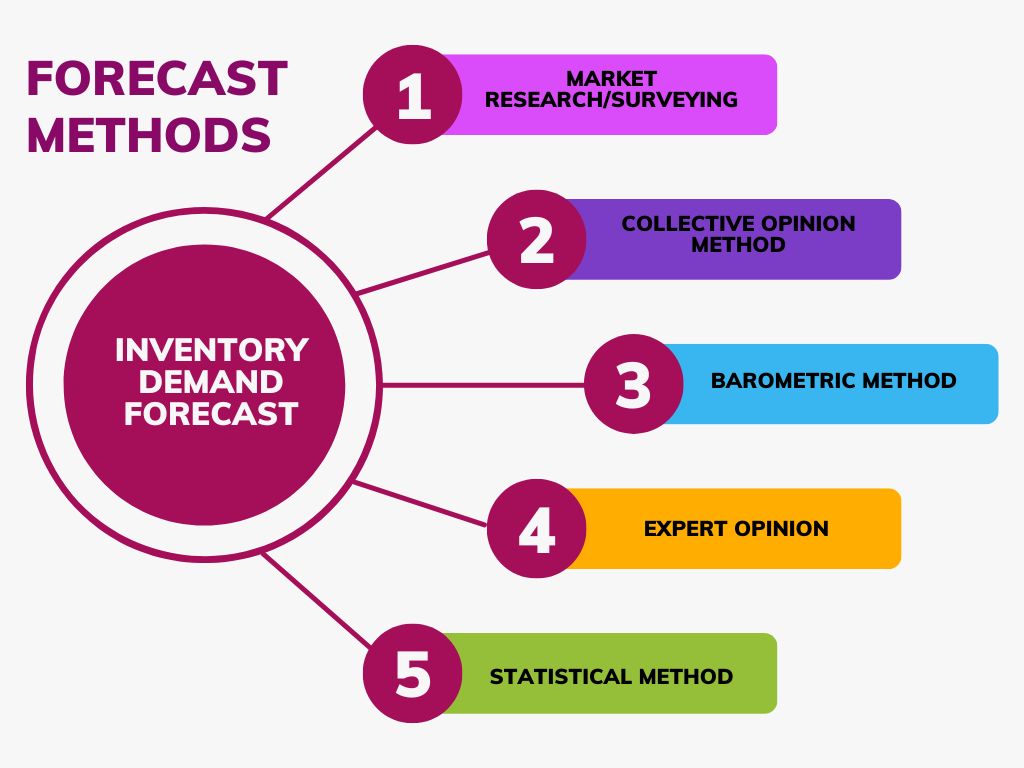
1. Market Research/Surveying:
In market research, market growth rates and trends related to products are two crucial factors for forecasting demand. Comparative reviews of related existing products versus new products can help calculate estimated needs. When a new product enters the market, human judgment and ratings are often used to evaluate its potential demand.
A/B testing is a popular term used by businesses in different sectors to discover better performance including promotions, features, email subject lines, and much more. A/B testing is a method where the performance of two different options is experimented with. If customers strongly favor one over the other, businesses gain a better understanding to appeal to forecasting demand.
For new types of products or services, historical data may not be available. In such cases, companies conduct market research through customer surveys to predict demand and ensure sufficient supply to meet customer expectations before launching the product or service.
Forecast demands for new products are pretty tricky compared to historical data analysis. An AI-powered software with good forecasting models can help you to analyze market research data and estimate demands.
For some types of goods, demand and customer preferences are changing rapidly, including the apparel and fashion industry. In this case, statistical methods may be less effective, and market research or surveys can be more useful for forecasting demand.
2. Collective Opinion Method:
In the collective opinion method, sales agents in their territories forecast demand. All territories’ data is analyzed centrally, and an overall company demand forecast is developed. Salespeople provide more accurate predictions because they have field experience with customers.
In this method, a company considers some common factors like product price, marketing campaigns, customer affluence, and competitive market position.
3. Barometric Method:
This forecasting method uses three indicators to predict demands.
- Leading indicators: Consider future events. For example, Increasing complaints from customers like shipping delays.
- Lagging indicators: Consider the impact of past events. For example, the growth of sales in the past month indicates it can be continued in the upcoming months.
- Coincidental indicators: Consider current events that are happening right now. For example, real-time sales.
The above three indicators can help you to create a more effective demand plan.
4. Expert Opinion Method:
Expert Opinion is another valuable method to forecast demand. An expert works in a specific industry for a long time and faces different types of situations in terms of demand. An expert has a better understanding of customers’ preferences and that’s why expert opinion or assumption is an effective method of forecasting demand.
The Delphi Method is a popular demand forecasting method that utilizes expert opinion. It was developed by the RAND Corporation in the 1950s and involves compiling the opinions of industry experts to forecast demand.
Process of Delphi Method:
- A questionnaire is sent to each expert and takes their opinions.
- Then the opinions are summarized by a facilitator and return the summary to each expert.
- Every expert reconsiders their opinion and is encouraged to update their earlier opinions in light of the replies of other experts.
This may continue for another round or two.
5. Statistical Method:
Statistical method using statistics to forecasting demand. This method analyzes historical data with a defined formula by using an advanced computerized tool. It’s a reliable, cost-effective, affordable method for all types and sizes of businesses.
A few ways to employ the statistical method :
- Trend projection: Trend projection forecasting is a simple and straightforward method for forecasting demand. It does not require complex formulas or tools, and involves simply looking at historical data to predict future trends.
- Regression Analysis: Regression analysis is a statistical method that identifies and models the relationships between different variables. By understanding how these variables are related, businesses can develop formulas to predict future outcomes, such as sales, conversions, and email signups.
Businesses that sell the same products year after year often have few new product launches. Historical data analysis cannot predict demand for new products because they have no sales history. However, demand for new products can be predicted based on the sales history of related products.
Inventory Optimization:
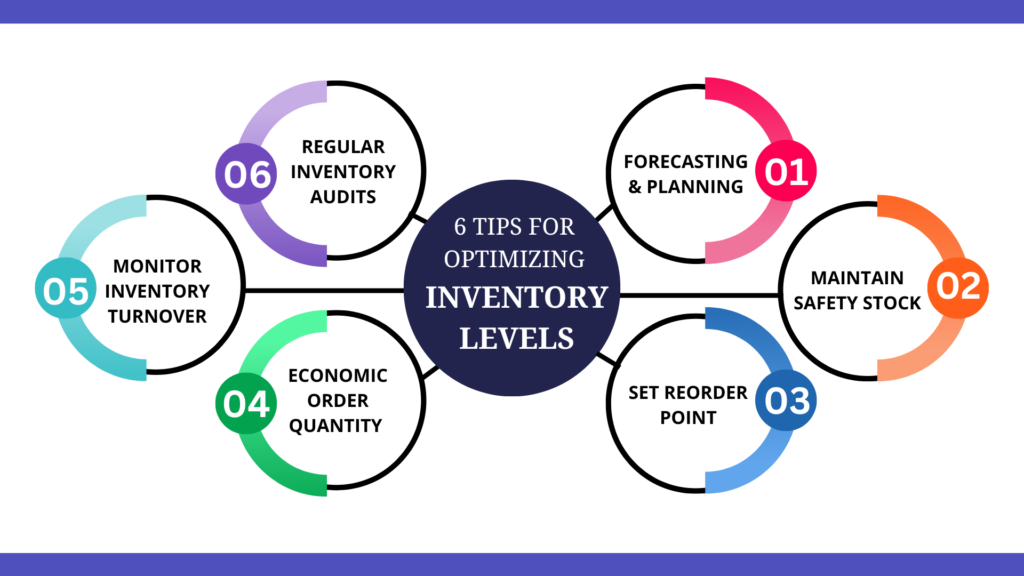
Inventory optimization unlocks your capital from unnecessary inventory.
Inventory optimization means keeping proper levels of stock according to demand, where you can avoid empty stocks, overstocks, and dead stocks. It reduces inventory holding costs, increases inventory turnover ratio and cash flows, and ensures maximum profits from minimum investment.
Relation Between Demand Forecasting & Inventory Optimization:
Demand forecasting calculates demands and generates suggestions to optimize inventory levels.
Data analysis and demand forecasting models calculate safety stock, reorder points, and lead times according to preferred periods or seasons. This helps to determine when to start purchasing and production when a product approaches its reorder point.
Safety stock: Safety stock is the amount of inventory that a company needs to keep on hand in order to ensure that it can meet customer demand. It is needed to make sure the company can still meet customer demand and to guard against production and order disruptions.
Customers may be dissatisfied if they cannot find the product they need in their local store, which is why safety stocks are important.
Reorder point: A reorder point (ROP) is the stock quantity of a product calculated based on previous demand. When the inventory level reaches the ROP, it signals that it’s time to order more (either through purchasing or production).
Lead days: The days required to receive items after placing the order.
Automated Demand Forecasting and Inventory Optimization:
In the past, inventory optimization was done manually, with a person updating the system manually. However, with the use of programs such as Google Sheets and Microsoft Excel, businesses can now automate this process.
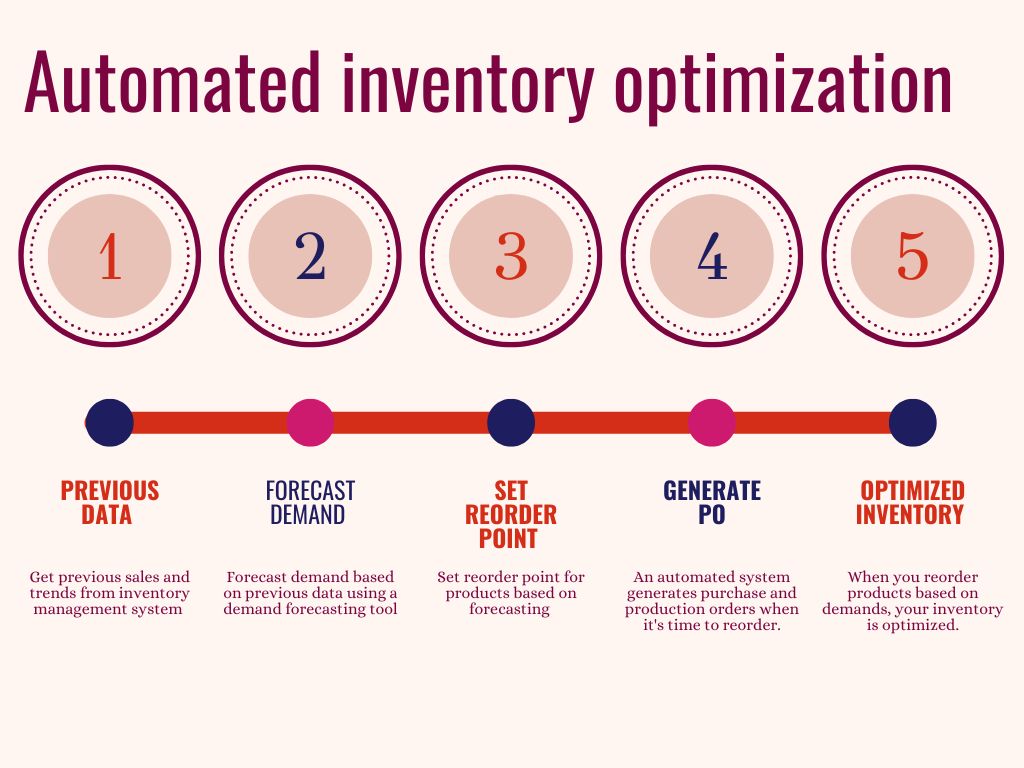
A combination of smart inventory management, demand forecasting, and inventory optimization tools can boost your business performance which helps you to manage your business and ensure sustainable business growth.
1. Previous sales data is obtained from the inventory management system:
To optimize inventory levels, you need to have previous inventory movement data from the inventory management system. An inventory management system may have additional features to forecast demand, or a third-party forecasting tool may be integrated with your inventory management system.
2. Forecast demand & set safety stock and reorder point:
Forecast demand by analyzing past sales data using a forecasting model. A computerized forecasting tool analyzes previous sales and trends, and sets safety stock and reorder points for specific products.
3. Automate purchase and production orders:
An automated software system generates purchase and production orders when it’s time to order. These auto-generated orders may be adjustable while orders are confirmed by a purchase manager or a production manager.
Benefits of Demand Forecasting & Inventory Optimization:
Demand forecasting and inventory optimization ensure the right amount of stock flows where you can easily avoid empty and unnecessary stocks. As a result, your business can ensure product availability according to the demands, unlock capital from excess inventory, and explore new opportunities to ensure sustainable business growth.
See the points below where demand forecasting and optimized inventory levels can improve your business performance:
Advantages of Demand Forecasting:
Demand forecasting helps to prepare for the future in terms of finance, production, and other factors that impact supply chains. It can increase profit margins, cash flows, and capabilities.
1. Preparing the budget for the future:
Demand forecasting helps prepare for the future in terms of finance, production, and other factors that impact supply chains. It can increase profit margins, cash flows, and capabilities by estimating future demands. This means you can get budget estimates for future inventory investments without tying up cash for unnecessary inventory. You can prepare for future budgets and finance the amount needed.
Without demand forecasting, you have no idea how much money you need to spend on inventory in the future. This can result in the inability to invest when needed, which can ultimately cause your business to collapse by losing sales, customers, and brand reputation.
2. Developing production facility and scheduling for the future:
When you know which products and how many quantities of specific items you will need in the future, you can prepare for both production facilities and manpower. Pre-scheduling for the future significantly improves your competitive advantage.
This allows you to give better customer service in terms of quality and on-time deliveries. Pre-scheduling also saves valuable time in making production plans, allowing you to focus on other opportunities.
3. Developing pricing strategy:
Prices and demand have a strategic relationship. Demand forecasting gives you an outlook of the demand and competition that can help you set appropriate prices strategically.
By understanding the market, you can discover potential opportunities and grow your business with competitive pricing.
When the demand for your existing product increases rapidly, you may consider increasing product prices by simply upgrading. However, this type of upgrading may be perceived as simply eyewash to increase prices.
If the demand decreases day by day, businesses often set discounted prices to sell all inventory and focus on new models or new products.
When a similar product of your competitor grows rapidly, it’s time to reduce current production and prepare for upgrading the existing product to beat the competitor. If you have a large amount of stock of the current product, it’s time to start a marketing campaign, possibly offering discounted prices, to sell the existing products before launching the new one.
Advantages of Inventory Optimization:
Inventory optimization refers to ensuring the good health of your inventory, keeping what you need fit. Inventory optimization provides many benefits, both directly and indirectly, that can greatly impact your business positively.
1. Reduce Operational Costs:
Through demand forecasting, you can optimize your inventory levels and reduce your operational costs associated with inventory management, including carrying, shipping, and holding costs.
If your business has poor inventory flow, where you have a large number of stocks to manage, you will need employees, laborers, and warehouse spaces, and your management and maintenance costs will be high. However, in the future, a portion of these stocks may become spoiled due to lack of demand.
Demand forecasting ensures the right levels of inventory based on customer demands, which can reduce your operating costs by removing unnecessary product handling and storage expenses.
2. Unlock Capitals From Unnecessary Storage:
Optimized inventory levels mean you have the stocks that your business needs, without excess stock that locks your capital in unnecessary storage. Sometimes, missed business opportunities are due to a lack of capital, but you may have enough capital locked in your warehouse due to excessive and unnecessary inventory that could potentially spoil.
Demand forecasting optimizes your inventory levels and unlocks capital from unnecessary storage, as well as unlocking business opportunities.
3. Help to Make Fast & Accurate Decisions:
Demand forecasting and inventory optimization help you make fast and accurate decisions. According to predictive analytics, data-based demand forecasting and inventory optimization software can automatically generate purchase and production plans, giving you a competitive advantage over your manually managed competitors.
4. Balance Inventory Levels:
Demand forecasting ensures stocks are based on customers’ demands. So, if you have customers, you have products, and if you have products, you have customers.
Demand forecasting helps balance stocks between demand and supply, which improves cash flows and increases business profits.
5. Improve Business Operational Performance:
To forecast demand and optimize inventory levels, you need a perpetual inventory management system with tracking capabilities. Improve customer deliveries based on commitments by tracking pipeline inventory, packing, shipping, and delivery status.
6. Boost Customer Satisfaction:
Sometimes, businesses have customers and orders, but they run out of stock and cannot fulfill the orders. It’s a common scenario in the SME business world due to poor inventory management. In such a situation, you lose orders, money, customers, and overall business reputation.
Demand forecasting helps businesses ensure that they have the right products in stock to meet customer demand. This keeps customers happy because they can find everything they need at your business.
Conclusion:
Demand forecasting is the process of estimating future customer demand. The idea behind inventory optimization is to ensure that there is always a sufficient quantity of products available to meet customer demand. Demand planning based on forecasts ensures optimized inventory levels and helps discover the most profitable way by controlling and adjusting inventory levels.
By using an advanced computerized tool, businesses can increase efficiency by automating this process. It also improves cost-effectiveness by ensuring the business has stocks for its needs.
Frequently asked questions:
Demand forecasting to optimize inventory levels is a pretty hot topic for smart business leaders. Here, I give some frequently asked questions about this topic.
What is demand forecasting in inventory management?
Inventory optimization is the practice of maintaining the appropriate inventory levels to meet customer demand while avoiding stockouts. With optimized inventory levels, you have enough stock without excess inventory. In simple terms, it means ensuring stock levels are based on demand.
How does demand forecasting affect inventory management?
Demand forecasting estimates product demand by analyzing complex patterns over time to produce more accurate and timely predictions. By using accurate demand forecasting, businesses can ensure optimal inventory levels with less stock and no stockouts, ultimately leading to increased revenue, profitability, and reputation.
How do you ensure the right amount of inventory?
To ensure the right amount of inventory, we must follow the typical steps:
- Sales trends analysis
- Know the supplier lead times.
- Calculate safety stock.
- Set the reorder point.
- Finally, ensure supply.
What is meant by inventory optimization?
Inventory optimization means balancing your inventory levels between supply and demand. Having too much inventory ties up your cash in unnecessary inventory, increases operating and holding costs. Moreover, due to stockouts, you miss sales along with damaging your reputation.
Why is inventory optimization important?
Inventory optimization is the process of balancing inventory levels with supply and demand to minimize costs and maximize sales. Too much inventory can increase costs and tie up cash, while stockouts can lead to lost sales and a damaged reputation.
Related Post:
Lead Time: Definition, How It Impacts Your Business, With Example
Lead times play an important role in your business profits where a little improvement can impact greatly fully and a little drown grading can reduce your revenues dramatically.
Read This ArticleTake a Quiz Test - Test Your Skill
Test your inventory management knowledge. Short multiple-choice tests, you may evaluate your comprehension of Inventory Management.
